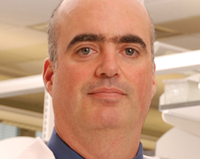 |
Ted Mikuls, M.D. |
 |
James O’Dell, M.D. |
The paper, which was published June 9 in Nature Genetics, sheds light on the nature of the disease.
The gene, dubbed REL, is a member of the NF-κB family, important transcription factors that play many roles in the body and contribute to regulation of immune response.
Scientist hope to find genetic triggers and identify treatments that block this autoimmune process.
Dr. Mikuls provides key support
UNMC faculty member Ted Mikuls, M.D., collaborated in the study that included more than 300 rheumatoid arthritis patients from the Veterans Affairs Rheumatoid Arthritis Registry (VARA).
“Dr Mikuls, through his leadership in national VA research, has helped make this discovery possible,” said James O’Dell, M.D., chief of the UNMC section of rheumatology and immunology and an international RA expert. “UNMC and the Omaha VA continue a pivotal roll in collecting well-characterized patient samples that make this genetic research possible.”
Discovery provides important insight to RA
Dr. Mikuls, who has been principal investigator of VARA since 2002, and Dr. O’Dell both said the identification of the genetic risk factor for RA is another important clue into understanding the complex disease.
“First, it adds to our rapidly evolving understanding of disease pathogenesis,” he said. “Perhaps more importantly, it provides another potential target in the development of novel strategies to treat rheumatoid arthritis.”
|
“The NF-κB is a key switching point for many cellular activities,” said Peter Gregersen, M.D., head of the Robert S. Boas Center for Genomics and Human Genetics at the Feinstein Institute for Medical Research, and lead author of the study.
The consortium has helped identify many genes involved in rheumatoid arthritis but this genetic finding is significant because of its key role in immune system regulation. It did not reveal itself in previous genetic studies because the sample size was just not large enough.
In previous studies, genetic samples from about 2,000 patients were used to identify markers associated with risk for RA. In the latest study, the scientists analyzed samples from 4,000 RA patients and controls – including the 300 from Dr. Mikuls’ registry.
Gene is common
According to Dr. Gregersen, this particular genetic variant is rather common, found in about a third of people in North America. Genetic differences between individuals help scientists understand many diseases. This is just the beginning, Dr. Gregersen said.
Today, most markers that are used to identify genes represent variants that occur in more than five percent of the population. The next wave in genetic screening will have to include the variants that occur in less than one percent of the population.